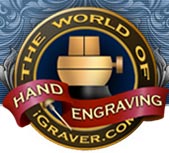One of the most popular borders of all time is the running wheat border. Sometimes call the wheat chaff, this border has been around since the earliest days of gun engraving. You'll also find examples of the running wheat border on custom knives, jewelry, and a variety of other engraved items. When done properly, it is a rich, elegant treatment for framing scrollwork, game scenes, or around the parameter of a circular or oval escutcheon. It's also strikingly beautiful when done in flush or raised gold.
Follow along and learn the fine points of engraving this classic border.

|
For this demonstration I've engraved two border lines 3mm apart. This does not mean that all wheat borders should be 3mm wide. you should choose a size that fits the job you're working on. Narrower than 3mm is fine, but if you go much wider than 3 or 4mm the border can look clunky and heavy. Thin examples usually look more elegant.
|
|
| I begin by drawing my first two leaves through a thin application of transfer wax. Once I decide on a pleasing distance between each leaf (in this case approximately 5mm), I set my dividers to this distance and mark off ladder rung segments. You'll find some engravers perfer leaves spaced closer together, and this is a matter of personal preference. In each segment I draw a boat shape. |
|
| After the boats are drawn, I mark where the nick cuts will be. The lowest nick cuts are placed about even with the tip of the leaf below. You may see variations of this spacing and placement with different engravers. |
|
| I cut one side of the boats first. This helps me to maintain consistency. My cut starts inside the border line and is cut in the direction of the leaf tip. The graver is rolled slightly to the inside to create a beveled cut. |





